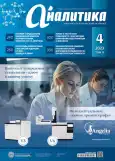Approaches to the Determination of Pseudomonas Aeruginosa in Water in the National and International Regulatory Framework
- Authors: Tymchuk S.N.1, Spiridonova E.J.1, Bugaevskaja L.V.1
-
Affiliations:
- JSC "ROSA"
- Issue: Vol 13, No 4 (2023)
- Pages: 300-305
- Section: Аналитика веществ и материалов
- URL: https://journals.eco-vector.com/2227-572X/article/view/631382
- DOI: https://doi.org/10.22184/2227-572X.2023.13.4.300.305
- ID: 631382
Cite item
Abstract
The methods used for the detection and identification of Pseudomonas aeruginosa (Pseudomonas aeruginosa) in various waters are considered. The main characteristics of the methods are compared, their disadvantages and advantages are given.
Attention is drawn to the conflicting requirements established in different methods, the low sensitivity of methods that do not provide for sample concentration, and the need to use outdated analysis procedures, as well as nutrient media with low growth and differentiating properties. Using the methods for determining P. aeruginosa in water as an example, it is shown that the domestic methodological base for sanitary control of water quality, including compliance with the requirements for packaged water (TR EAEU 044 / 2018), needs to be modernized taking into account international experience in this field.
Full Text
About the authors
S. N. Tymchuk
JSC "ROSA"
Author for correspondence.
Email: mail@rossalab.ru
кандидат медицинских наук
Russian Federation, MoscowE. Ju. Spiridonova
JSC "ROSA"
Email: mail@rossalab.ru
Russian Federation, Moscow
L. V. Bugaevskaja
JSC "ROSA"
Email: mail@rossalab.ru
Russian Federation, Moscow
References
- SanPiN 1.2.3685-21. Hygienic standards and requirements for ensuring the safety and (or) harmlessness of environmental factors for humans. Postanovlenie Glavnogo gosudarstvennogo sanitarnogo vracha RF. 28.01.2021. No. 2.
- SanPiN 2.1.4.1116-02. Drinking water. Hygienic requirements for the quality of water packaged in a container. Quality control. Postanovlenie Glavnogo gosudarstvennogo sanitarnogo vracha RF. 19.03.2002. No. 12.
- SanPiN 2.3.2.1078-01. Food raw materials and food products. Hygienic requirements for the safety and nutritional value of food products. Postanovlenie Glavnogo gosudarstvennogo sanitarnogo vracha RF. 14.11.2001. No. 36.
- ТР ЕАЭС 044 / 2017. On the safety of packaged drinking water, including natural mineral water.
- Guidelines. Detection and identification of Pseudomonas aeruginosa in environmental objects (food, water, waste liquids), 1984. 17 р.
- Tymchuk S. N., Ahapkina E. N., Larin V. E., Budanova E. V., Nechaev D. N. All that glitters is not gold. Kontrolʹ kachestva produkcii – Product quality control, 2017; 10:18–24.
- Tymchuk S. N., Ahapkina E. N., Larin V. E., Budanova E. V., Nechaev D. N. One step forward, two steps back. The effectiveness of methods for the determination of Pseudomonas aeruginosa in water. Kontrol’ kachestva produkcii – Product quality control, 2017;11:49–56.
- МU 2.1.4.1184-03. Guidelines for the implementation and application of sanitary and epidemiological rules and regulations SanPiN 2.1.4.1116-02. Moscow. Federal’nyj Centr Gossanjepidnadzora Minzdrava Rossii Publ., 2003. 68 p.
- GOST 34786-21. Drinking water. Methods for determining the total number of microorganisms, coliform bacteria, Escherichia coli, Pseudomonas aeruginosa and Enterococcus. Moscow. Rossijskij Institut Standartizacii Publ., 2021. 32 p.
- ISO 16266 : 2006. Water quality – Detection and enumeration of Pseudomonas aeruginosa – Method by membrane filtration, 11 p.
- ISO 8360-1 : 1988. Water quality – Detection and enumeration of Pseudomonas aeruginosa – Part 1: Method by enrichment in liquid medium. 1988. 10 p.
- GOST ISO 16266-2018. Water quality. Detection and enumeration of Pseudomonas aeruginosa. Method by membrane filtration. Minsk. Gosstandart Publ., 2018. 11 p.
- GOST R 54755-2011. Food products. Methods for detection and quantity determination of Pseudomonas aeruginosa bacteria. Moscow. Standartinform Publ., 2012. 16 p.
Supplementary files








